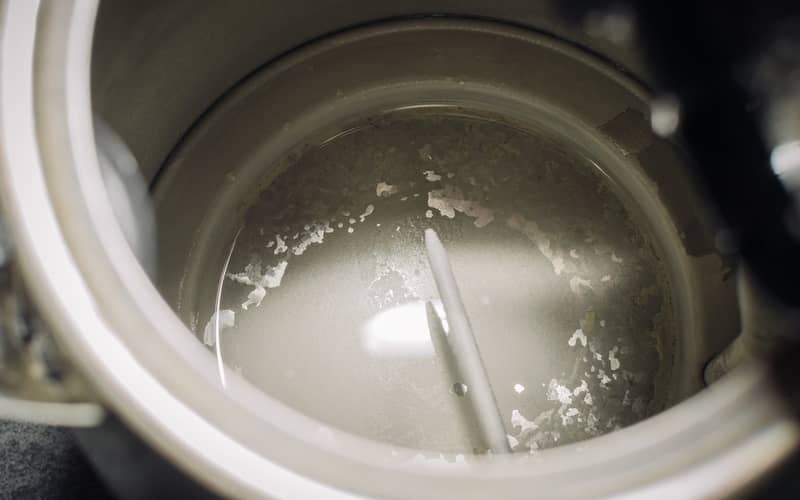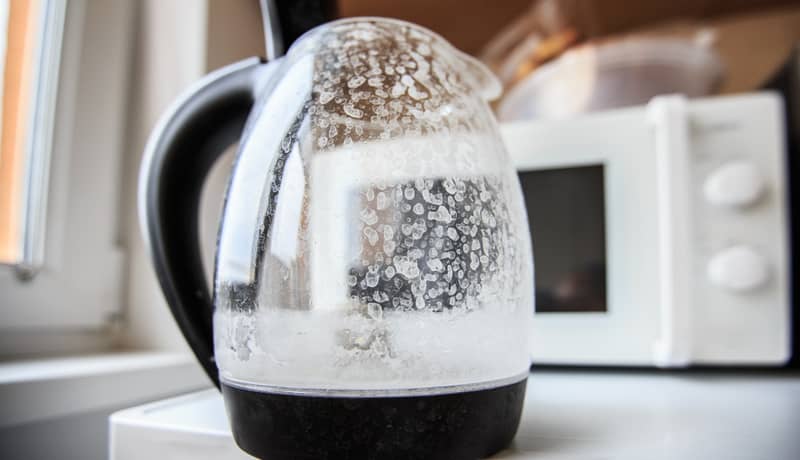If you’re like many of us in the world, you can’t get through a day without a morning cup of coffee or an evening mug of tea.
And a clean kettle is essential for heating water for your drink, since it keeps things hygienic and prolongs the lifespan of your appliance.
One important step of cleaning a kettle is descaling – removing limescale build-up from the kettle’s surfaces.
How to descale a kettle? Some easy methods use:
- Bicarb soda
- Lemon
- Vinegar
- Citric acid
- Descaler
Reportedly, Australia is one of the top 20 countries that drink the most tea! Don’t compromise your chamomile cravings with calcium carbonate – and don’t worry, descaling is easy-peasy.
Why Descale Your Kettle?

If you live in an area with hard water – or if you don’t have a water softener – limescale build-up is a bit inevitable.
The water will leave mineral deposits, like calcium carbonate and magnesium, on the surfaces of a metal kettle over time. It looks white or off-white and feels gritty to the touch.
(Fun fact: it’s also called kettle furring!)
Limescale by itself isn’t hazardous to your health, but it doesn’t look great. Leaving limescale to build up can also lead to mould or bacteria growing on the deposits.
Descaling a Stove Top Kettle vs Electric Kettle
Stovetop and electric kettles work differently, but the descaling process is the same for most kettles.
Limescale build-up occurs on most metal, ceramic, and glass kettles. On the other hand, plastic kettles are less likely to accumulate limescale on their surfaces.
Be mindful with an electric kettle, though – the heating element cannot get wet, or you could damage the mechanisms. Never submerge it in water.
How Often to Descale a Kettle
This will depend on how often you use it! But it’s important you clean your kettle regularly to minimise build-ups.
You can spot clean the exterior weekly to remove limescale from drips and spills.
If your kettle has one, clean the filter once every two months (or as recommended by the manufacturer).
At the very least, descale your kettle every 2-3 months. If you notice an odd taste in your morning coffee or a build-up of white residue, clean it ASAP!
How to Descale a Kettle Naturally
Before descaling, make sure you’re done using the kettle! It’ll be out of commission for an hour or two, so it’s best to descale the kettle at the end of the day.
Wash out any loose limescale by removing the filter on your kettle (if present).
Fill it halfway, then swish the water around so it washes against the kettle’s interior.
Pour it out along with any limescale bits afterwards.
Descaling a kettle with bicarbonate of soda

This is a great natural method for descaling, but it can get messy! Have some paper towels or rags handy to clean up any drips.
Ensure your kettle is switched off, unplugged, and completely cool. Make a slightly thick paste with bicarb soda (baking soda) and warm water.
Use an old toothbrush or soft-bristled brush (like a bottle brush) to apply the bicarb soda paste on the interior surfaces and scrub gently. Don’t forget the spout as well!
When you’ve removed the limescale, wipe the residue off with a damp cloth or rinse with clean water.
Fill the kettle and quickly boil the water, then pour it out. Then boil some more water to check the quality and taste.
Descaling a kettle with lemon

This is one of the preferred methods of kettle cleaning, since it leaves a more pleasant odour than vinegar.
Fill your kettle with equal parts lemon juice and water. (Save the cut halves for later!) If you’re short on lemons, you can reduce this to 1 part lemon juice to 3 parts water.
Set the kettle to boil, then take it off the stove or let it switch off and unplug it. Wait about 20-30 minutes, then use a soft-bristled brush or old toothbrush to scrub the kettle inside and out.
You can wear rubber gloves so you don’t dry or irritate your skin with the lemon water.
Pour out the lemon water. For stubborn residue, you can take those cut lemons and use them to directly scrub the deposits.
Rinse the kettle a few times in warm water, then boil some more water to remove the lemon taste.
Descaling a kettle with vinegar

Distilled white vinegar is acidic, so it’s fairly effective for limescale removal. It also works on most materials, so you can use it to clean a glass kettle as well.
However, be sure to open any windows or turn on an exhaust fan! Boiling distilled white vinegar can create a funky odour that could give you a headache.
Mix equal parts white vinegar and water (cold water is fine) in your kettle so it’s about halfway full. Bring the solution to a boil, then remove the kettle from the stove or let it switch off and unplug it.
Allow the solution to sit for 10-20 minutes, then use an old toothbrush or bottle brush to scrub off the limescale build-up. Pay attention to any edges and crevices!
Pour out the white vinegar solution and rinse the kettle a few times. You can also remove the vinegar odour by boiling water with a tablespoon or two of bicarb soda.
NOTE: Don’t let the vinegar solution sit for too long, or it could etch the stainless steel or degrade any rubber seals.
Descaling a kettle with citric acid
If you don’t keep citric acid around your home, now’s a good time to start! It’s one of the easiest ways to descale a kettle and other appliances (like your coffee machine).
Fill your kettle about halfway with water, then add 1-2 tablespoons of citric acid (depending on your kettle’s volume). Bring it to a boil, then take the kettle off the stove or let it switch off and unplug it.
Let the mix sit for about 20 minutes, then pour it out. Use a soft-bristled brush to scrub off any limescale deposits.
You can make a thin citric acid paste for any stubborn stains. Rinse the kettle afterwards, then boil some water to check the quality and taste.
How to Descale a Kettle with Descaler

One other easy method for removing limescale is to use a dedicated descaler! These can come as a liquid, powder, or tablet.
After using a descaler, you can quickly wash the kettle’s interior with some dish soap and water to remove any residue.
Be mindful of the heating elements in electric kettles.
Liquid descaler
To descale your kettle with liquid cleaner (like the Breville Eco Liquid Descaler), dilute the descaler according to the product instructions.
Pour into the water reservoir and follow your manufacturer’s instructions. Rinse thoroughly afterwards.
Powder descaler
To descale a kettle using powder, dissolve the appropriate amount in warm water and pour it into the reservoir. Bring the mix to a boil, then discard the solution.
Boil some fresh water one or two times afterwards to rinse.
For powder descalers, try the Urnex Descaling Powder Solution.
Tablet descaler
To descale a kettle with tablets, use 1 tablet at a time. Add about 0.5-0.7 litres of water at about 40ºC to the kettle, then dissolve the tablet.
Check out the WoldoClean Descaler Tablets, which will also work on coffee makers and espresso machines.
Follow your kettle’s descaling instructions or use a soft-bristled brush to scrub the surfaces. Rinse with clean water afterwards.
How to Descale the Kettle Filter

Some kettles (especially electric ones) have filters located at the base of the spout. Hard water can leave deposits on the filter as well.
Remove the filter before cleaning, then let it soak in some hot, soapy water or a mix of hot water and vinegar.
Leave for 5-10 minutes, then scrub with a soft-bristled brush.
If the limescale won’t come off, you may have to replace the kettle’s filter.
FAQs About Descaling Kettles
Need more tips or useful info about how to descale a kettle? Here are answers to some common questions!
What is the fastest way to descale a kettle?
Any method that involves boiling a cleaning agent in the kettle directly will be quickest.
That includes white vinegar, lemon juice, citric acid, or a descaler product.
What dissolves limescale in kettles?
Several cleaning agents in your home can dissolve limescale, including vinegar and lemons.
Acidic cleaners are effective, but don’t leave them for too long or you could etch the metal.
Descaling products will also dissolve limescale.
How to prevent limescale build-up?
Hard water will always leave limescale deposits over time, but there are ways to minimise or prevent build-up.
Try to boil just as much water as you need, so you don’t leave water standing inside the kettle. If there’s leftover water, use it to clean something else in your kitchen (like the sink).
Try to use filtered or distilled water in your kettle if available. Alternatively, install a water softener in your home – this will prevent limescale from building up in other areas too, like your shower.
Wipe the exterior weekly to prevent water spots and limescale deposits.

